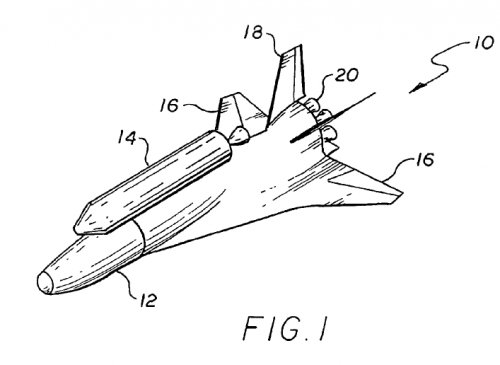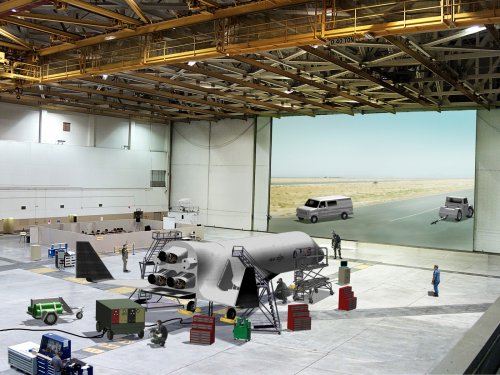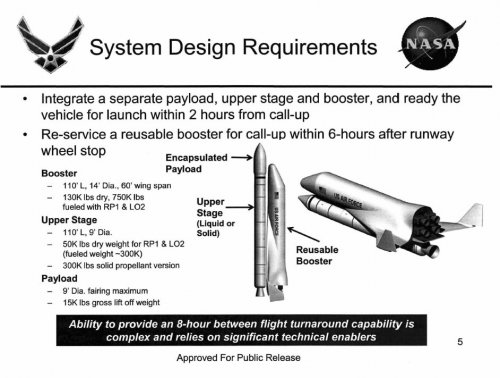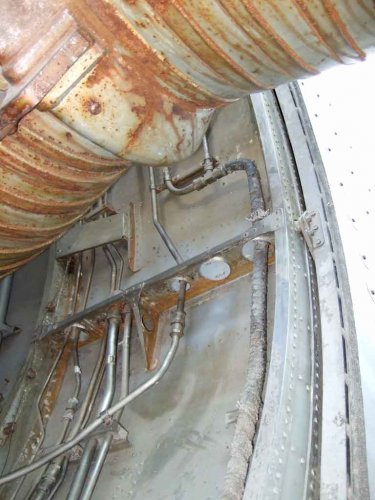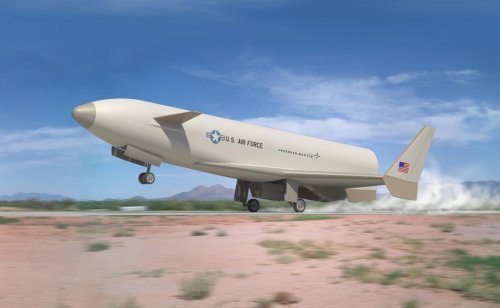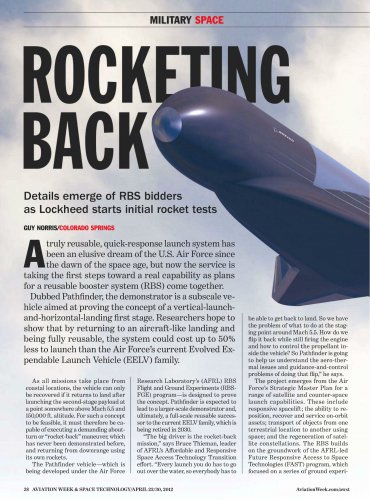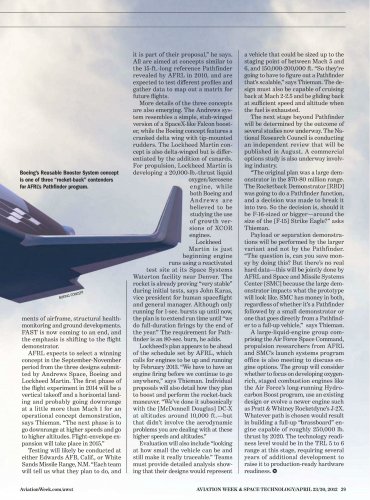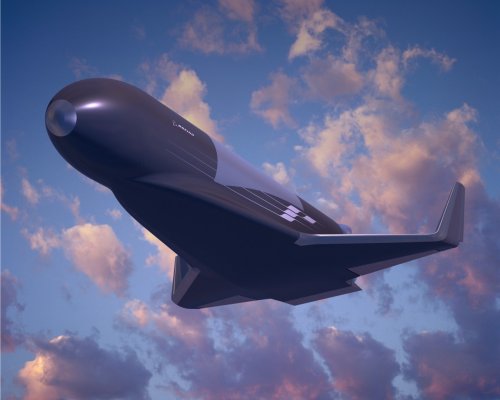AvLeak from last year
USAF Plans For Reusable Booster Development
Apr 25, 2010
By Graham Warwick
Washington
Plans to begin technology development for a reusable booster system to replace its existing expendable launch vehicles beyond 2025 are being finalized by the U.S. Air Force.
With the Air Force facing escalating costs on the Evolved Expendable Launch Vehicle (EELV) program, the new system offers the promise of cutting launch costs more than 50% by combining a reusable first stage with expendable upper stages. The booster would take off vertically and return to a runway landing at the launch site.
The next-generation Reusable Booster System (RBS) architecture is defined in a spacelift development plan now in the final stages of coordination within the Air Force.
“The plan will go up to Space Command within the next month or two,” says Ken Hampsten, head of spacelift for the Space and Missile Systems Center’s developmental planning division. “There is a very good business case for replacing the EELV,” he says.
The plan calls for replacing the Atlas V and Delta IV with two versions of the RBS: a single reusable first stage and expendable cryogenic upper stage for medium-lift missions; and two reusable boosters, cryogenic core stage and upper stage for heavy-lift and growth missions. Initial operational capability is set for 2025, with the EELVs being phased out in 2030 once the Air Force is comfortable relying on the RBS, he says.
“The EELV is rapidly escalating in cost,” says Hampsten, in part because of increased overhead resulting from the Obama administration’s decision to cancel development of NASA’s Ares I crew launch vehicle. “At lower flight rates, the RBS does very well,” he says. At the Air Force’s nominal rate of eight launches a year, “we get at least a 50% cost saving, and that’s before the cost growth now hitting us.” The business case is based on a 100-flight reusable booster life, with the engines being replaced after every 10 flights.
The first step in the spacelift plan is to begin technology development for the reusable booster, including demonstrators for the autonomous first stage and its liquid-oxygen/kerosene engines. The first of these is the Air Force Research Laboratory’s (AFRL) RBS Pathfinder, planned to fly in 2013 to demonstrate the preferred “rocket-back” return-to-launch-site maneuver. This would be followed in 2016-17 by the RBX, a “moderately large-scale” demonstrator representative of the operational system.
Rocket-back was selected after extensive analyses that included unpowered glide-back and turbine-powered jet-back maneuvers. Using the main rocket engine to reverse the booster’s flight path allows staging at a higher Mach number than with glide-back, for a smaller upper stage, while the downrange distance and reentry velocity after the flip-over maneuver are lower than jet-back. This reduces the need for reusable thermal protection on the first stage, says Jeff Zweber, AFRL’s RBS Pathfinder program manager.
But pirouetting the winged vehicle 180 deg. involves extremely high angles of attack and slideslip, and the aerodynamic loads at high altitudes cannot be adequately measured in existing tunnels, so the Pathfinder is intended as a “wind tunnel in the sky,” Zweber says. AFRL plans to award three $1.5-million study contracts, then downselect to one team for a $28.5-million contract to build the demonstrator. The 15-ft.-long Pathfinder will be ground- or air-launched on three flights to test different rocket-back maneuvers.
The follow-on RBX flight demonstrator is expected to be 50-60 ft. long and “highly representative” of the operational unmanned, reusable booster, Hampsten says. Both subscale vehicles are expected to be powered by existing engines available from the entrepreneurial space industry, he says, while a parallel AFRL demonstration program, called Hydrocarbon Boost, will develop a large LOX/kerosene rocket engine for the full-size booster.
Cancellation of its Ares I may be helping drive up EELV costs, but NASA still plans to develop the heavy-lift Ares V and needs a large hydrocarbon rocket motor, so it has begun talks with the Air Force on joint development.
“NASA is coming into the picture,” says Hampsten. “We realize there is only enough money to develop one engine.”
From March 2011
Dayton Business Journal
Date: Tuesday, March 22, 2011, 12:46pm EDT
A new $250 million U.S. Air Force program to develop a reusable booster system for space flights has been launched from Wright-Patterson Air Force Base.
The Air Force Research Laboratory’s Air Vehicles Directorate, which is based at Wright-Patt, issued the request for proposals on Monday.
Officials anticipate awarding up to three contracts for the project, where winners would compete for individual tasks of experiments and demonstrations that address technology, processes and other attributes of a reusable booster system, or RBS.
Air Force officials envision an RBS that includes a reusable rocket and an expendable upper stage rocket. The reusable rocket would be launched vertically and return, landing aircraft style on a runway, after carrying the space craft to a point where the expendable rocket could take over.
While there are not any Dayton-area businesses expected to land a prime contract role on the program, some local companies are expected to vie for subcontract work.
The deadline for proposals is May 19.
News surrounding rocket boosters has heated up recently.
The Wall Street Journal is reporting that United Launch Alliance, the Colorado-based launch-services joint venture of Boeing Co. (NYSE: BA) and Lockheed Martin Corp.(NYSE: LMT), will work with XCOR Aerospace Inc. on the development of lower-cost rocket booster engines.
The report said ULA plans to join with Mojave, Calif.-based XCOR to develop a new upper-stage engine for ULA’s Delta IV and Atlas 5 launchers.
ULA and XCOR, a privately held rocket-engine and spaceflight-development company, have partnered before on a variety of projects.

